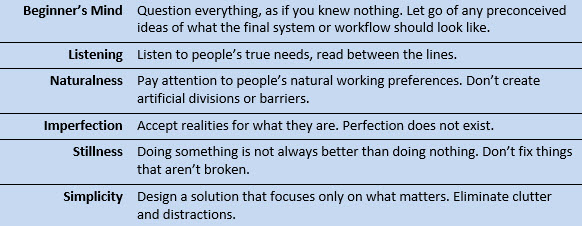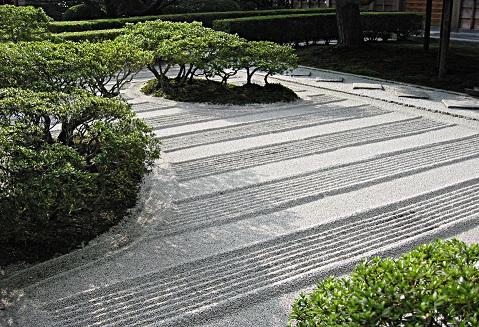In the first part of this post I explored some fundamental truths about GIS and why, inspired by the principles of Design Thinking, a good GIS strategy needs to focus on people not technology.
In this second and final part I shall explore how to go about creating a successful GIS strategy, using a simple and effective approach.
Zen and the art of GIS strategy design
Design Thinking shares some similarities with Zen wisdom. Zen is a very simple philosophy which is fiendishly difficult to describe. It is not the purpose of this blog to get into the meaning of life, but Zen offers a number of principles which are useful for designing a GIS strategy:

Beginner’s Mind
This principle is one of the main reasons why companies often ask for outside help when designing a strategy. It is easier for a fresh pair of eyes to look at problems which may be burdened with historical baggage or corporate politics. An independent consultant can draw out true requirements, mediate between different parties and work seamlessly across silos. Besides, a consultant can also bring in fresh perspectives and best practices from across the industry – but, one step at a time, we are getting ahead of ourselves!
Listening and Naturalness
Before even beginning to sketch out a tentative strategy, the principles of Listening and Naturalness need to apply. To design a GIS strategy we spend most of our time onsite simply listening to people. We find out what makes people tick and what their natural preferences are, because not every strategy will work for every type of organisation. Some people need flexibility; others prefer prescriptive processes. Some people yearn for ready-made solutions; others want to take control. Some people just need to visualise data; others require a more analytical workflow. We often find that by simply listening to people the strategy almost designs itself, right there in front of our eyes.
Imperfection
This is a potential stumbling block. It is not easy for people who take pride in their jobs to accept imperfection. The perfect strategy however does not exist, and neither does perfect data or technology. There is always the temptation of delaying a strategic improvement project until a “better time.” It is all too easy to hold back because there’s an organisational issue to be clarified, or the data is not clean enough, or there’s the eternal promise of future technology releases. But as Zen author Alan Cohen once said, “don’t wait until all the conditions are perfect for you to begin – beginning makes the conditions perfect.” It is all about progress, not perfection.
This is also where measurement comes in. To know where you’re going, you first need to know where you are. There are various metrics that can be used for GIS (see for example Exprodat’s Maturity Matrix model). And once you have measured where you are, you can track progress not only against yourself but also compare yourself to industry peers. Such benchmarking can be a very powerful motivator, and provide useful insights as well as best practices (if you are interested in joining our ‘Benchmarking Club’ do get in touch).
Stillness and Simplicity
Last but not least, Stillness and Simplicity drive the actual design of the GIS strategy. Stillness requires that you leave those things alone that don’t need tweaking, and pick your battles carefully. Focus only on the use cases that really matter. This is particularly important for something as versatile as GIS technology. The applications are almost limitless and so you need to prioritise.
There are also many other aspects to consider beyond mere use cases – these include user awareness & training, governance & ownership, data management & automation, data integrity, or technology choices. Unless an organisation is reorganising, or starting from scratch, it should not need major improvements in all of these areas. So you need to target the implementation accordingly.

Introducing some Zen into your GIS landscape.
(Photo: Paul Mannix, Flickr CC)
Keeping it going
These Zen-derived principles should help a great deal in defining a solid GIS strategy. If you ever get stuck along the way, you can always seek inspiration from the company’s business strategy. And if there isn’t one, or it is unclear, you have probably found the root of all problems.
A strategy is only as good as its implementation. The cult novel Zen and the Art of Motorcycle Maintenance observes that true contentment comes from being able to not just ride a bike but also fix it. It is all about balance. If your sole focus is on riding into the sunset you will one day find yourself stranded on a deserted road with a broken bike. On the other hand, someone who is too much into tinkering with the machine might never set off on that big ride.
Similarly, a successful GIS implementation requires a holistic outlook that knows where to go whilst understanding what goes on under the hood, so the journey doesn’t come to an abrupt halt. And like all motorcycles, a GIS needs continuous upkeep and care: not just the tools but the whole system – people, information, technology. Without regular maintenance, the strategy will just gather dust in a file drawer and the GIS system will eventually come to a halt. This may well provide some stillness but it won’t help the advancement of company goals.
Posted by Thierry Gregorius, Principal Strategic Consultant, Exprodat.
References & Bibliography
- Seven Design Principles Inspired by Zen Wisdom, Matthew May, Fast Company.
- What Zen Taught Silicon Valley (And Steve Jobs) About Innovation, Warren Berger, Fast Company.
- Zen and the Art of Motorcycle Maintenance, Robert Pirsig, Vintage Books.
- Alan Cohen quote from http://zenquotes.org/alan-cohen-quotes/





